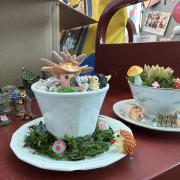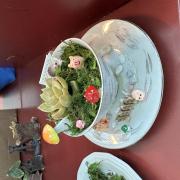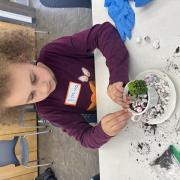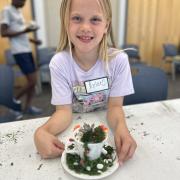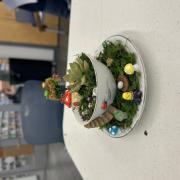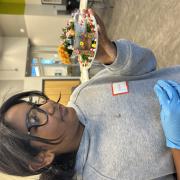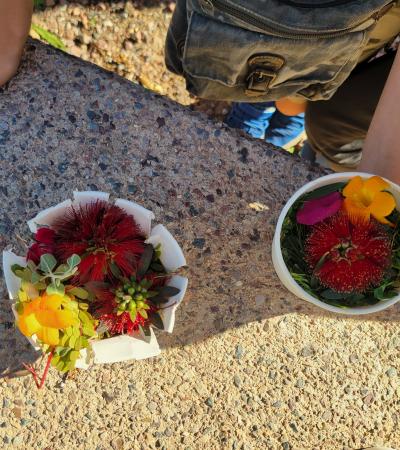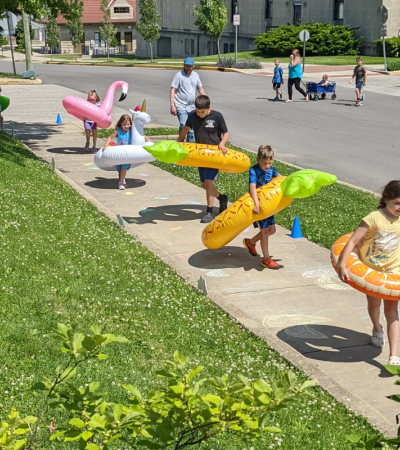Our library system has identified distinct categories of programming called "signature services." The Teacup Fairy Gardens program was developed as a part of a series called Creativity Unleashed, which falls under the STEAM signature service category.
In this program, children explore their inner artist and celebrate spring by making a fairy garden inside a teacup. This program gave children the opportunity to design their own gardens and provided them with valuable information about caring for succulents.
Advanced Planning
There were two outcomes of this program: children would develop their unique skills and confidence to express themselves through creativity and learn how to plant and care for succulents.
Through research on opportunities to engage children in a unique experience, I saw blogs where adults created fairy gardens in teacups. I began researching, creating a supply list, and a budget, and developed an action plan to make it a children's program. This step was around three to four hours.
After identifying the foundation of the program and learning outcomes, I developed my working knowledge of how to care for succulents. I created handouts through Canva to provide support to children and their caregivers to help the succulent thrive and I came up with the structure for the program. This step was around two to three hours.
The last step in preparation was creating an example to display for the children and assembling the materials to set up the program. This took around one to two hours.
Overall, the total preparation time for this program was around seven to nine hours. The planning started in February and the program took place in late April.
Marketing
We have a slideshow that displays the upcoming programs on our public-facing monitor. Calendars were also printed out and I created a flyer through Canva with a QR code to the registration link.
Since this program was part of a series, I told those in attendance at the March program about it so that they were aware of it when registration opened.
The targeted audience was children ages 8 - 11 with a limited registration of 15 children. We only allow people to register two weeks out from the program.
The marketing was a huge success. All spots were filled within the first few days of registration being open. We even had two families who waited to see if someone registered could not make it so they could take the spot.
Budgeting
The program costs were $130 in total.
The supplies purchased were around three packages of bulk fairy garden figures, bulk animal mini fairy garden figures, moss, gravel and mini benches from Amazon. The mini succulents were purchased in packs of six and the succulent-specific potting soil was purchased from Lowes.
The other items we had on hand were buckets and glue guns. We received a donation of 16 teacups with saucers to utilize for the program.
There are many options for cutting costs for this program.
- Reduce the size of people allowed to register.
- Reduce the amount of figurines that each child can use to create their garden.
- Ask participants to provide their own teacups (if you are unable to get a donation of them).
- For teacups and figurines, you can also shop around flea markets and thrift shops.
- Eliminate the succulents (some fairy gardens are simply just decorative).
Day-of-event Activity
For this event, I needed enough room for 15 spots at the tables for the space to create. I also placed chairs at the back of the room for caregivers.
The tables were positioned in a wide U configuration, so everyone could see my table to watch the demonstrations. I also had four tables behind me that were set up with pieces in different categories within labeled stations. I also had two tables, on each side of the room, positioned for gluing pieces. One last table was placed in the middle of the U to be the demonstration table.
There was one other staff member to help me set up and tear down. Only one staff member conducted the program.
The only unexpected challenge was finalizing the decision of how to set up the pieces so that children could easily choose them. I was afraid the tables would look too bare, but it turned out to be better when the pieces were laid out on the tables.
Program Execution
We had 15 children attend the program. At the beginning of the program, I had already laid out vinyl gloves, napkins, and a name tag (with a color border). The color border was important because it represented the group the child would be in for rotations. There were chairs along the back for the caregivers to bring up or sit in the back if their child was older.
I created signs that labeled each table at the front as station #1 - 4 and the gluing stations (with a sign that caregivers needed to be present). Each child picked a seat and they wrote their name on their name tag. Once we settled, the children were told that their nametag color represented what group they were in, and for everyone to have their first choice of something they would be rotated to the tables. I gave each rotation one minute and they were told once they selected their items to return to the table until the minute was up to give everyone a chance at their current rotation to choose their items. I had the children rotate through all four stations.
After that, I talked to them about plant care and the different ways to go about creating their garden and planting their succulent. They first were instructed to put gravel in the bottom of their teacup to help create an internal draining system since there weren't holes for drainage. I also talked about succulents and the basics of caring for them. Each child was guided through the planting process. Once that was complete, the children were able to plan the design of their fairy garden. After they completed the design process, they went with their caregiver to the gluing stations to create their final product.
At the end, I provided them with handouts that I created to provide them with guidance on caring for their succulent and brand-new fairy garden. I also discussed that if they liked this program, they could check out one of the books on other types of gardening.
We have increased the visibility of our programming and several families have requested additional programs on this topic. Children were also engaged and did check out books to further their knowledge of gardening. The parents provided feedback that they love the Creativity Unleashed series because it allows their children the opportunity to have unique experiences. Most of this was ad hoc feedback from individuals, but we also have comment cards.
Advice
I would highly recommend creating a sample ahead of time and even walking through it with a child before conducting a program with multiple children. The rotations worked really well for everyone to have a fair chance at choosing something first.
This has been one of my most successful programs. If you are thrifty and can reach out to landscaping companies, and the community and look at places like Dollar Tree, it's an incredible program that is worth the time and effort.

